Research on impact of tablet devices in schools
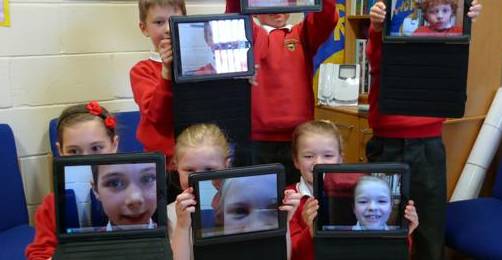 http://www2.hull.ac.uk/ifl/ipadresearchinschools.aspx – the first national evaluation to investigate the use and impact of tablet technologies (specifically the iPad), across Scottish schools and local authorities was undertaken by a research group based in the Faculty of Education at the University of Hull and published in March 2013. The study investigated a range of issues associated with the deployment of personal mobile devices as tools for teaching and learning.The study focused on four principal themes related to the use of mobile devices as personal tools for teaching and learning. These were:
http://www2.hull.ac.uk/ifl/ipadresearchinschools.aspx – the first national evaluation to investigate the use and impact of tablet technologies (specifically the iPad), across Scottish schools and local authorities was undertaken by a research group based in the Faculty of Education at the University of Hull and published in March 2013. The study investigated a range of issues associated with the deployment of personal mobile devices as tools for teaching and learning.The study focused on four principal themes related to the use of mobile devices as personal tools for teaching and learning. These were:
• How tablet devices impact on teaching and learning
• The leadership and management issues associated with the deployment of mobile devices in schools and local authorities
• Parental engagement with learning when students use mobile technologies as personal devices
• Professional development and learning for teachers introducing personal mobile devices into the curriculum
The headlines findings from the study show that:
• The ownership of a personal mobile device, like the iPad, facilitates many of the pedagogical aspirations set out in Scotland’s Curriculum for Excellence framework.
• The adoption of mobile technologies on a personal basis significantly increases access to technology for students, both inside and beyond school, with many attendant benefits for learning which include greater motivation, engagement, parental involvement, and understanding of complex ideas.
• Personal ‘ownership’ of the device is seen as the single most important factor for successful use of this technology
• Teachers are equally engaged by the use of a device like the iPad which has a low learning curve enabling them to use it immediately as a teaching tool and a learning tool for themselves
• The use of the device is contributing to significant changes in the way teachers approach their professional role as educators and is changing the way they see themselves and their pedagogy:
• Parents also appear to become more engaged with the school and their child’s learning when the iPad travels home with the student
The full report findings can be found by following the link below:
http://www2.hull.ac.uk/ifl/ipadresearchinschools.aspx
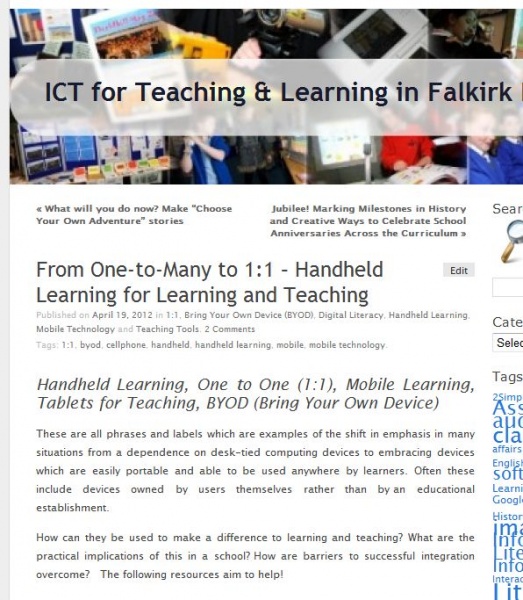 http://glo.li/NWgGQT An overview of resources supporting educational establishments making a move to mobile devices has been collated here: http://glo.li/NWgGQT This covers the rationale behind the move to using mobile devices, studies on the impact on learning and teaching, practical implications for schools, acceptable use policies, recommendations for classroom management, examples of experiences of schools, and ideas shared by many teachers on ways to use mobile devices to enhance the learning and teaching experience across the curriculum.
http://glo.li/NWgGQT An overview of resources supporting educational establishments making a move to mobile devices has been collated here: http://glo.li/NWgGQT This covers the rationale behind the move to using mobile devices, studies on the impact on learning and teaching, practical implications for schools, acceptable use policies, recommendations for classroom management, examples of experiences of schools, and ideas shared by many teachers on ways to use mobile devices to enhance the learning and teaching experience across the curriculum.
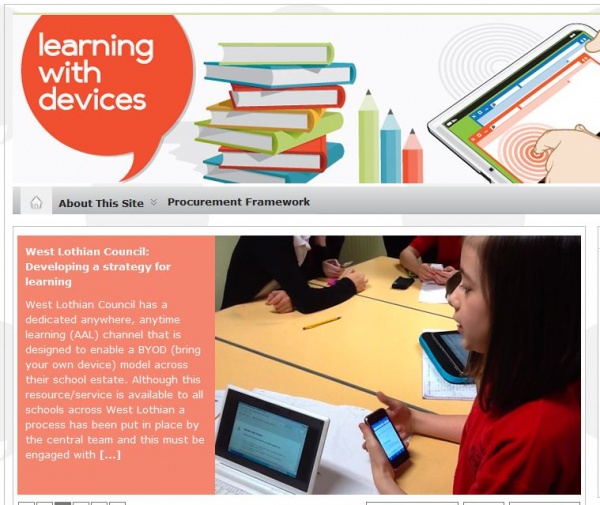 https://blogs.glowscotland.org.uk/glowblogs/learningwithdevices/ The use of tablet devices in supporting learning and teaching is documented at Education Scotland’s Learning with Devices site which details experiences from various schools (pupils, school staff and parents) around Scotland.
https://blogs.glowscotland.org.uk/glowblogs/learningwithdevices/ The use of tablet devices in supporting learning and teaching is documented at Education Scotland’s Learning with Devices site which details experiences from various schools (pupils, school staff and parents) around Scotland.
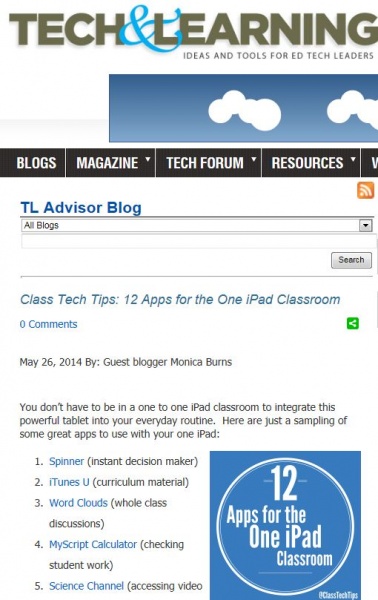 12 Apps for the One iPad Classroom – if your school or classroom is in the early stages of using mobile tablet devices there may well be only one tablet device per class at the beginning stages. If that’s the case then this post by Monica Burns may be helpful as it provides suggestions for apps which will be useful where there is only one iPad tablet device in the classroom.
12 Apps for the One iPad Classroom – if your school or classroom is in the early stages of using mobile tablet devices there may well be only one tablet device per class at the beginning stages. If that’s the case then this post by Monica Burns may be helpful as it provides suggestions for apps which will be useful where there is only one iPad tablet device in the classroom. iPads4Schools The One iPad Classroom – this post on the iPad4Schools blog describes some apps and some guides to workflow (storing and sharing work done by multiple pupils through the one iPad) which will work where a class has access to only one iPad tablet device.
iPads4Schools The One iPad Classroom – this post on the iPad4Schools blog describes some apps and some guides to workflow (storing and sharing work done by multiple pupils through the one iPad) which will work where a class has access to only one iPad tablet device.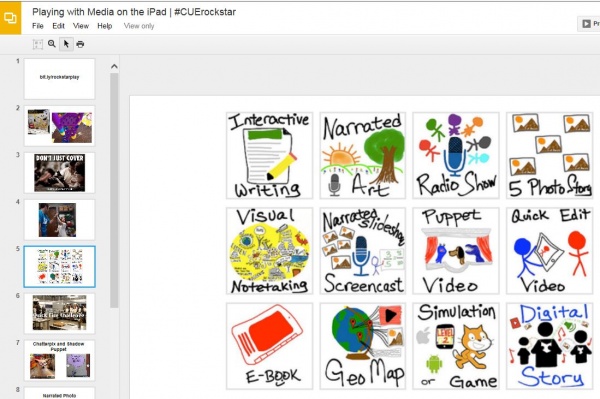 Playing with Media on the iPad – #CUERockstar – ideas and links to resources for use with an iPad (though ideas can translate to other devices) including ideas for when a device is a shared device to manage class folders of images. Describes various tasks and suggested apps which can be used to undertake the tasks.
Playing with Media on the iPad – #CUERockstar – ideas and links to resources for use with an iPad (though ideas can translate to other devices) including ideas for when a device is a shared device to manage class folders of images. Describes various tasks and suggested apps which can be used to undertake the tasks.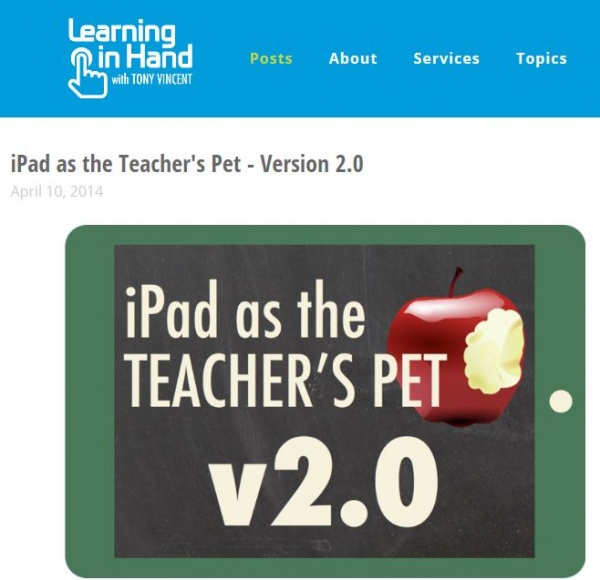 iPad as the teacher’s Pet v2.0 – a post by Tony Vincent which sets out how a teacher can use a single iPad ior tablet device in a classroom, even where pupils do not have devices, for many different purposes. Each is described and illustrated with visual infographic posters.
iPad as the teacher’s Pet v2.0 – a post by Tony Vincent which sets out how a teacher can use a single iPad ior tablet device in a classroom, even where pupils do not have devices, for many different purposes. Each is described and illustrated with visual infographic posters. Awesome Android Apps for students and teachers
Awesome Android Apps for students and teachers

 Danny Nicholson on his Whiteboard Blog has provided a useful review and guide to using Socrative
Danny Nicholson on his Whiteboard Blog has provided a useful review and guide to using Socrative Gathering Student Feedback with Socrative
Gathering Student Feedback with Socrative


